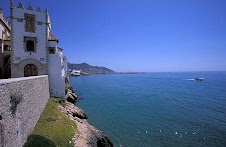Sitges has 17 sand beaches. Four of them are in the East: the first one called Les Botigues at the beginning of the coast, next to the beachs of Castelldefels and the other three are following the coast of Garraf (Road C-31). There are eleven urban beaches and two in the west. These last two have difficult access. The last one (Playa del Muerto) is the gay beach.
The main beach in May, in the background the church of Sant Bartomeu I Santa Tecla
All the eastern and urban beaches have access facilities, flags indicating the state of the sea and most of them have quality diplomas and blue flags awarded by the European Union.
Modern Sitges, preserving important references from the Middle Age and the old farmers’ and fishermen’s town, offers visitors an impressive architectural and cultural heritage, the result of initiatives by artists, cultural energizers and patrons like Santiago Rusiñol, Ramon Casas, Miquel Utrillo or Charles Deering.
Thanks to them, Sitges was a reference point for writers, musicians and other intellectuals and became an important center for disseminating Modernism and the "Americanos", who, after returning with their "fortune" from their American adventure, commissioned large mansions from Modernist and Noucentista (post Art Nouveau) architects.
The museums, guided tours or walks around the old quarter allow us to visit and relive this important legacy. This creative impetus has made it possible to create new projects like The International Barcelona-Sitges Vintage Car Rally, the International Film Festival, the International Jazz Festival or the Summer Concerts Series.
For over 100 years, Sitges has been celebrating nonstop –between the months of February and March, according to the liturgical calendar- Carnestoltes, or Carnival.
The festivities begin on Dijous Gras, or Fatty Thursday, with the arribo, King Carnestoltes’ spectacular arrival. From the moment this character appears until the burial of the sardine – late afternoon on Ash Wednesday – you could well say that life in Sitges moves to a new beat.
Here there is even room for youngsters to step into the limelight with children’s ruas, or Carnival parades, on Sunday and Tuesday afternoon.
Folk dances and xatonades (traditional local salad served with assorted omelets) are also characteristic carnival elements. The two most important moments are the Rua de la Disbauxa, or the Debauchery Parade, on Sunday night and the Rua de l‘Extermini, or Extermination Parade, on Tuesday night. Some forty-odd floats with more than 2.000 participants leave a jam-packed Sitges completely breathless.
Beach & Culture in Sitges
Subscribe to:
Post Comments (Atom)






No comments:
Post a Comment